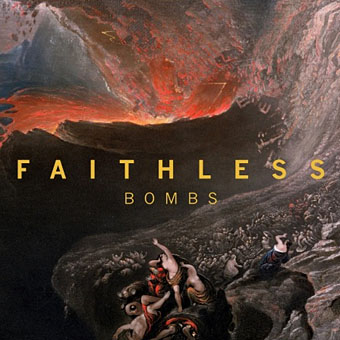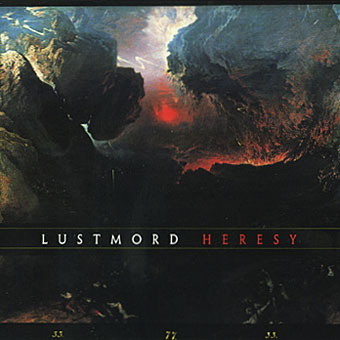
The apocalyptic spectacles of Romantic painter John Martin are routinely treated by art critics as kitsch, a dismissal which ignores the considerable power and perennial attraction that many of his best pictures possess. Kitsch is a bad thing, it seems, unless you’re Jeff Koons or Jake and Dinos Chapman.
Martin’s most famous work, The Great Day of His Wrath, has raised its tumultuous head again on the cover of Bombs, a recent single by Faithless. The painting depicts a scene from the Book of Revelations with city-capped mountains being upturned onto terrified sinners while lightning cuts through the sky. The video for the song is an anti-war affair by Howard Greenhalgh, juxtaposing innocuous images of everday life with weapons being fired and soldiers being attacked, often in the same shot. So a happy family skips along a beach while a mushroom cloud grows on the horizon. The moral guardians at MTV have duly banned this in order to spare the delicate sensibilities of America’s teenagers. And they wonder why people like YouTube so much? Or Google Video?

Faithless are a bit late to John Martin’s table, Lustmord featured the painting in full on the cover of Heresy in 1990, an album whose doomy rumbles I much prefer to the duo’s lightweight soul. Better late than never, I suppose.
Previously on { feuilleton }
• The apocalyptic art of Francis Danby
• The Enigma of Desiderio

“The apocalyptic spectacles of Romantic painter John Martin are routinely treated by art critics as kitsch, a dismissal which ignores the considerable power and perennial attraction that many of his best pictures possess. Kitsch is a bad thing, it seems, unless you?re Jeff Koons or Jake and Dinos Chapman.”
John this reminded me a lot of my own dismay at finding Odd Nerdrum referred to constantly in terms of kitsch.
http://thenonist.com/index.php/weblog/comments/2062/
Seems a quite similar case.
I often wonder at the fact that we as moderns are expected to be awed by the allegorical and mythological paintings of the past but to wink and snigger at the same kind of universal subject matter when painted today. A great painting is a great painting, is a great painting…
If today we can still believe that allegories and myths are truths (bible, koran, etc), and allow them to guide our lives, why can’t we paint in that same spirit?
Fascinating, I didn’t see your Nerdrum post until now. And oddly enough (as it were) I only discovered Nerdrum recently thanks to a tip from a friend.
This issue has been close to my heart for a very long time, since school in fact, when I began to realise that there was a whole world of painting that was quarantined as “bad” (kitsch in this context is usually a less direct term that means essentially that: bad painting), and that a lot of what I was enjoying was on the wrong side of the fence. I’ve skirted around this in recent posts about Thomas Häfner and Martin’s contemporary, Francis Danby. The revelation, as I said before, came when entering the Tate Gallery at the age of 13 and seeing Martin’s massive canvases, including The Great Day of His Wrath, and wondering why they weren’t featured in any art history books, especially when Turner (who was in the books, of course) started out painting similarly grandiose subjects in a very similar manner.
Not all art critics have a problem with this kind of art but the majority seem to. Marina Warner is more enlightened in this respect, and fully capable of tracing the parallel history of fantastic and imaginative imagery. I think some of the trouble is a hangover from the Clement Greenberg period (to which you refer) that saw any form of realism in painting as being bad per se. Photorealism in the 1970s was a minor diversion and not encouraged; even today painting is still valued the most if it’s messy and we can see the hand of the artist at work.
The thing that struck me about Martin’s work was that he’d dared to imagine what “the plains of heaven” or the end of the world might look like, then painted exactly that with great attention to detail. It’s the detail, the realism, the quality of the picture as a window rather than a surface, that the critics seem to dislike. I’ve no time for the dismal reactionaries at ARC (although they provide good picture scans…ahem) who want to turn the artistic clock back to 1900, I’ve painted myself in a hyper-realist manner and a “painterly” manner also. But I still love being thrilled by the exercise of imagination and it’s this that thrills me about Martin or the Symbolists or, of course, the Surrealists.
The imagination is the key here, they don’t like to see too much of it on display. Nerdrum is imaginative in just this “wrong” way. There’s a similar snobbery in the literary world which routinely sneers at genre fiction (sf, fantasy and horror) unless it’s produced by, say, Margaret Atwood, when it suddenly becomes literature. Chris Foss–sf book jacket artist of the 1970s–would never be seen by the art world as a serious artist, he’s merely an illustrator who made lots of paintings of enormous spaceships. Glenn Brown on the other hand is treated seriously (and nominated for the Turner Prize) when he makes exact copies of the work of Foss or sf artist Tony Roberts. The act of putting quotation marks around someone else’s work makes you an artist today, it seems. I’d almost put money on there being an art student somewhere who thinks they’re being clever by making copies of Glenn Brown’s copies…
The bottom line is always: enjoy what you want to enjoy, and don’t like or dislike things out of the approval or disapproval of other people. And if anyone tells you that what you like is in bad taste, remind them of my favourite quote from Picasso: “Good taste is the enemy of creativity.”